When preparing sun-cooked meals, you'll want to make smart ingredient swaps for the best results. Replace dry meats with marinated tofu or bean-based alternatives that work well at room temperature. Swap regular oils for high smoke-point options like avocado or canola oil, or use Greek yogurt as a healthy fat alternative. Choose moisture-rich vegetables like tomatoes and cucumbers to prevent drying, and add mashed bananas or applesauce as natural binders. For thickening, opt for arrowroot over cornstarch, as it works at lower temperatures. Use smoked paprika and curry spices to enhance flavors without traditional heating methods. These simple substitutions open up a world of solar cooking possibilities.
Moisture-Rich Vegetables for Long Cooking
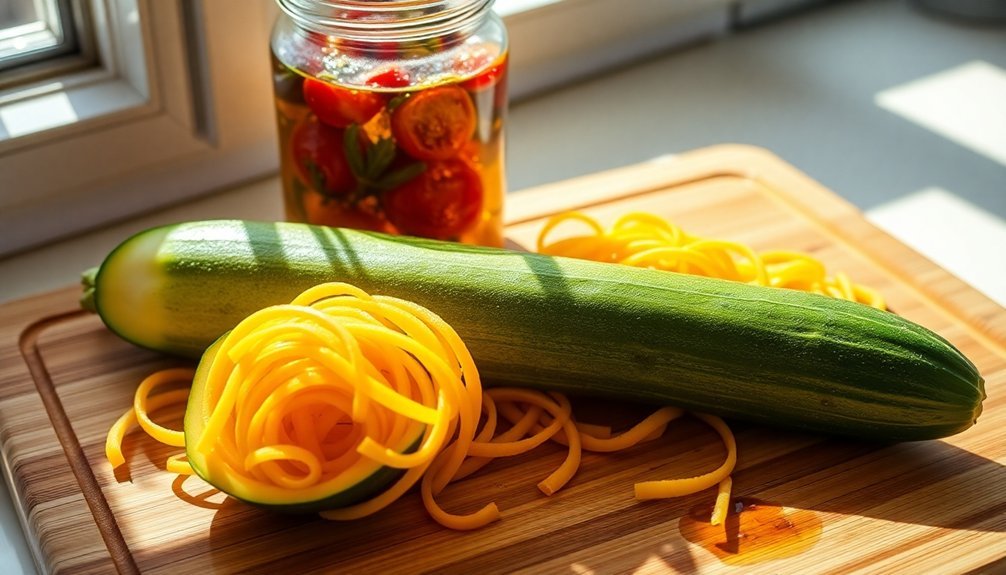
When preparing sun-cooked meals, selecting vegetables with high water content provides natural moisture that prevents dishes from drying out during extended cooking times.
You'll want to focus on vegetables like tomatoes and mushrooms, which release beneficial compounds during slow cooking. Tomatoes become even more nutritious as they cook, increasing their lycopene content by over 50% within 30 minutes.
Combine moisture-rich options like cucumbers (96% water) and spinach (93% water) with denser ingredients. The cooking process breaks down cell walls in these vegetables, making their nutrients more accessible to your body.
For best results, chop broccoli and let it rest for 40 minutes before cooking to maximize its nutritional benefits.
When using mushrooms, you'll get more antioxidants as they cook, thanks to the release of ergothioneine.
Remember to avoid soaking your vegetables, as this can lead to nutrient loss.
Solar-Safe Oil Alternatives
When preparing sun-cooked meals, you'll want to opt for oils with high smoke points like avocado or canola oil to prevent rancidity under prolonged heat exposure.
You can also consider Zero Acre oil, which remains stable at temperatures up to 485°F while offering environmental benefits.
For oil-free alternatives, try using natural moisture-rich ingredients like pureed vegetables or fruit concentrates to maintain proper consistency in your solar dishes. Greek yogurt can also provide moisture and richness while reducing fat content in sun-prepared recipes.
Light Oils For Heat
Since solar cooking involves varying temperature ranges, selecting the right oil for your sun-prepared meals is essential for both safety and flavor. For best results in your solar cooker, choose oils with high smoke points like avocado or safflower oil when you're expecting temperatures above 450°F. If you're cooking at moderate temperatures, canola or grapeseed oil will serve you well. Proper storage techniques will help maintain the quality of your oils between solar cooking sessions, so keep them in a cool, dark place.
| Oil Type | Smoke Point | Best Solar Use |
|---|---|---|
| Avocado | 520°F | High-heat dishes |
| Safflower | 510°F | Baking, roasting |
| Canola | 400-446°F | General cooking |
| Grapeseed | 421°F | Medium-heat meals |
| Olive (Extra Virgin) | 350°F | Low-heat recipes |
You'll want to avoid extra virgin olive oil and coconut oil for high-temperature solar cooking, as their lower smoke points can lead to bitter flavors and potentially harmful compounds.
Non-Oil Natural Options
Looking to reduce or eliminate oils in your solar cooking? You'll find plenty of natural substitutes that work effectively in sun-prepared meals.
Applesauce and fruit purees can add moisture while binding ingredients together, perfect for solar-baked goods. For creamy textures, try Greek yogurt or buttermilk – they'll enhance flavors while keeping your dishes moist.
Mashed bananas serve multiple purposes, acting as a binder while adding natural sweetness and moisture to your recipes. Using vegetable stock for sautéing provides a healthy alternative while maintaining flavor in your dishes.
If you need a specific oil replacement, try a cornstarch solution (4 teaspoons per cup of water, boiled and cooled). You'll need to adjust other liquids in your recipes when using these alternatives, but you'll achieve delicious results that are often healthier than their oil-based counterparts.
Sun-Friendly Meat Substitutes
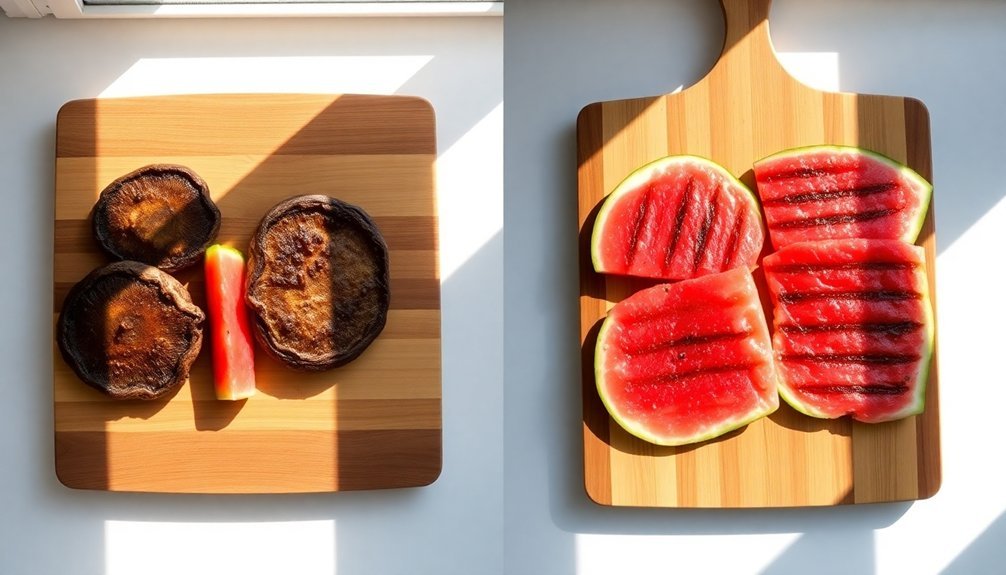
You'll find that marinated cold tofu steaks offer an ideal protein-rich alternative for sun-prepared meals, as they don't require heating and absorb flavors beautifully while chilling.
Bean-based BBQ alternatives, such as chickpea or black bean patties, can be prepared ahead and served at room temperature with traditional cookout fixings.
These sun-friendly meat substitutes not only keep well in warm weather but also provide complete protein while maintaining food safety standards in outdoor settings.
Marinated Cold Tofu Steaks
When preparing sun-friendly meat alternatives, marinated cold tofu steaks offer a delicious and protein-rich option that doesn't require traditional cooking methods.
Start with extra firm tofu, press it for 10 minutes, and slice it into appealing steak-sized pieces. Score the surface in a crosshatch pattern to help the marinade penetrate deeper.
You'll want to combine savory ingredients like soy sauce, liquid smoke, and garlic powder, then let the tofu marinate for at least an hour in the refrigerator.
- Perfectly pressed tofu squares with crisp, clean edges and professional crosshatch scoring
- Rich, amber-colored marinade coating every surface of the tofu
- Beautifully trimmed pieces with rounded corners, resembling traditional steaks
- Glistening surface with visible herbs and spices clinging to each piece
Bean-Based BBQ Alternatives
Three satisfying bean-based BBQ alternatives can transform your sun-friendly meal prep without traditional cooking methods. You'll find these protein-rich options are perfect for outdoor dining, requiring minimal heat preparation.
| Bean Type | Quick Prep Method | Suggested Pairing |
|---|---|---|
| Navy Beans | Mix with maple syrup & liquid smoke | BBQ chickpea burgers |
| Pinto Beans | Blend with fire-roasted tomatoes | Stuffed baked potatoes |
| Mixed Beans | Combine with vegan Worcestershire | Grilled vegetables |
| Chickpeas | Toss with tomato puree | Broccoli slaw |
| Black Beans | Stir with caramelized onions | Tofu BBQ kebabs |
These alternatives don't require soaking when using canned beans, and you'll love how they're freezer-friendly for advance prep. The combinations of sweet, smoky, and savory flavors create satisfying meals that maintain their taste whether served hot or cold.
Heat-Stable Grain Options
Selecting the right heat-stable grains forms the foundation of successful sun-prepared meals.
You'll find that rice and quinoa are particularly versatile options that maintain their quality in varying temperatures. When you're planning your sun-prepared dishes, these grains can be pre-cooked, portioned, and frozen to save time while preserving their nutritional value.
- Vibrant quinoa bowls topped with colorful roasted vegetables and herbs
- Savory rice medleys mixed with seasonal produce and protein
- Multi-grain combinations featuring wheat, barley, and oats for texture
- Hearty grain-based curry dishes that travel well
For best results, you can cook these grains in large batches using your slow cooker or Instant Pot.
Remember to store them properly in airtight containers to maintain freshness and guarantee food safety throughout your outdoor dining experience.
Quick-Cook Bean Replacements
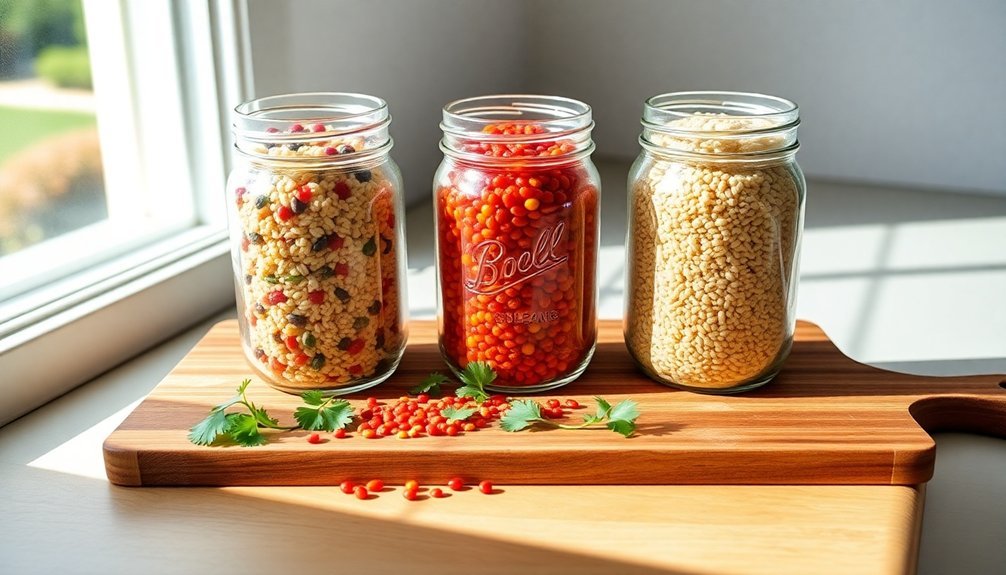
Building on your grain-based foundations, beans offer another versatile component for sun-prepared meals. You'll find quick-cooking options like adzuki beans and lentils that don't need soaking, making them perfect for efficient meal prep. For other varieties, try the quick-soak method: bring your beans to a boil, then let them rest for an hour in hot water.
| Bean Type | Best Used In | Cooking Time |
|---|---|---|
| Adzuki | Sweet dishes, soups | 45-60 min |
| Cannellini | Hummus, stews | 60-90 min |
| Lentils | Curries, salads | 20-30 min |
When you're substituting beans, remember that white beans can replace chickpeas in hummus, while pinto beans work well in place of kidney beans for chili. Don't forget to enhance flavor by adding aromatics like garlic and herbs during cooking.
Solar-Ready Sauce Thickeners
Thick, flavorful sauces don't need to rely on traditional stovetop cooking methods. When preparing solar-cooked meals, you'll want to choose thickeners that work well at lower temperatures and don't require extensive heat manipulation.
Arrowroot is your best friend here, as it thickens at lower temperatures than other starches and won't break down in your solar cooker.
- A glossy stir-fry sauce that catches the sunlight, thickened with a smooth arrowroot slurry
- A clear, shimmering broth transformed into gravy using potato starch
- A rich egg-based sauce that coats your vegetables with golden elegance
- A naturally reduced tomato sauce that concentrates its flavors in the solar cooker's gentle heat
For best results, mix your starch-based thickeners with cold water before adding them to your solar-heated sauce, and remember that egg-based thickeners need careful temperature monitoring.
Natural Solar Cooking Seasonings
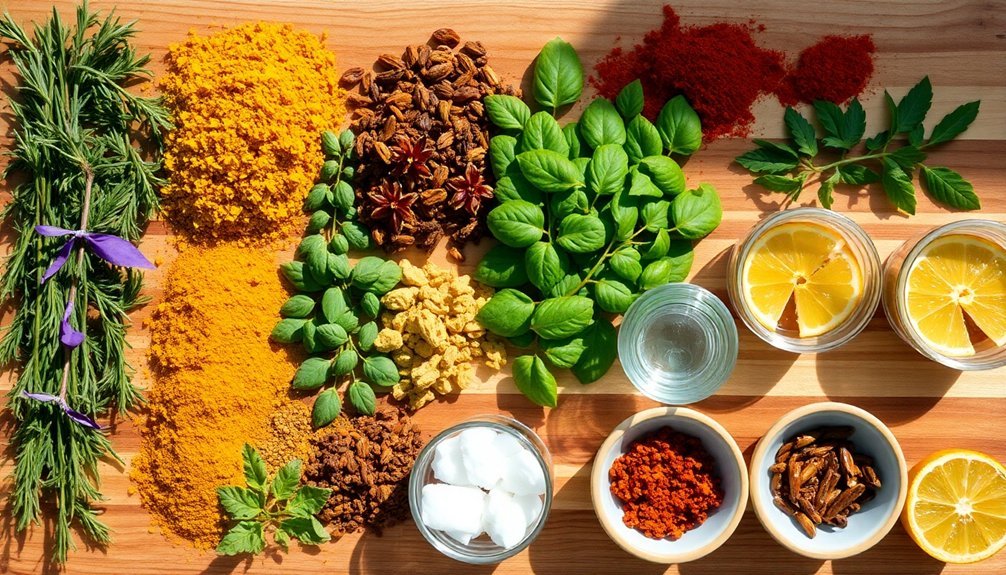
Beyond the art of thickening sauces lies the vibrant world of natural seasonings that bring solar-cooked dishes to life.
You'll find that herbs like thyme and aromatic ingredients such as garlic and onions form the foundation of flavorful solar meals.
Whether you're craving Mediterranean, Moroccan, or Mexican flavors, you can easily adapt your solar cooking with the right spice combinations.
Try smoked paprika or Spanish pimenton for a smoky depth, or blend curry spices for an Indian twist.
Don't forget to enhance your dishes with natural flavor boosters like olive oil, honey, or a splash of lemon juice just before serving.
For richer, more complex tastes, you can incorporate optional ingredients like crumbled bacon or Worcestershire sauce, while bullion cubes work well in solar-cooked stews and soups.
Frequently Asked Questions
How Long Can Sun-Cooked Meals Safely Remain in Solar Ovens Before Spoiling?
You'll need to remove sun-cooked food from your solar oven within 2-4 hours if temperatures drop below 140°F. Keep monitoring the thermometer and don't leave meals overnight unless properly cooled.
Can You Use Marinated Ingredients When Cooking With Solar Power?
Yes, you can definitely use marinated ingredients in solar cooking. Your marinades will work just as well as in traditional cooking methods, and they'll help keep your food moist and flavorful during the solar cooking process.
What Containers Are Safest for Solar Cooking at High Temperatures?
You'll want to use dark metal pots with tight-fitting lids, as they're safest for high-temperature solar cooking. Make sure they're food-grade materials and have heat-resistant handles. Avoid plastic containers that could melt.
Do Cloudy Days Affect the Nutritional Content of Sun-Cooked Foods?
You'll find that cloudy days don't directly affect your food's nutritional content. While it'll take longer to cook on cloudy days, the gentle, low-heat method still preserves nutrients just like on sunny days.
Which Spice Combinations Work Best to Mask the Earthiness of Solar Cooking?
You'll find curry spices and beef ramen seasonings work best to mask earthiness. When combined with cumin, garlic, and cayenne pepper, they'll create bold, savory flavors that overpower any unwanted earthy taste.
In Summary
You'll find these seven simple recipe swaps transform your solar cooking experience. By choosing moisture-rich veggies, stable oils, and quick-cooking proteins, you're ensuring successful sun-prepared meals every time. Whether you're replacing traditional grains with faster alternatives or using natural thickeners, these adaptations work perfectly with solar cooking's gentle heat. Keep these swaps handy, and you'll master the art of cooking with sunshine.

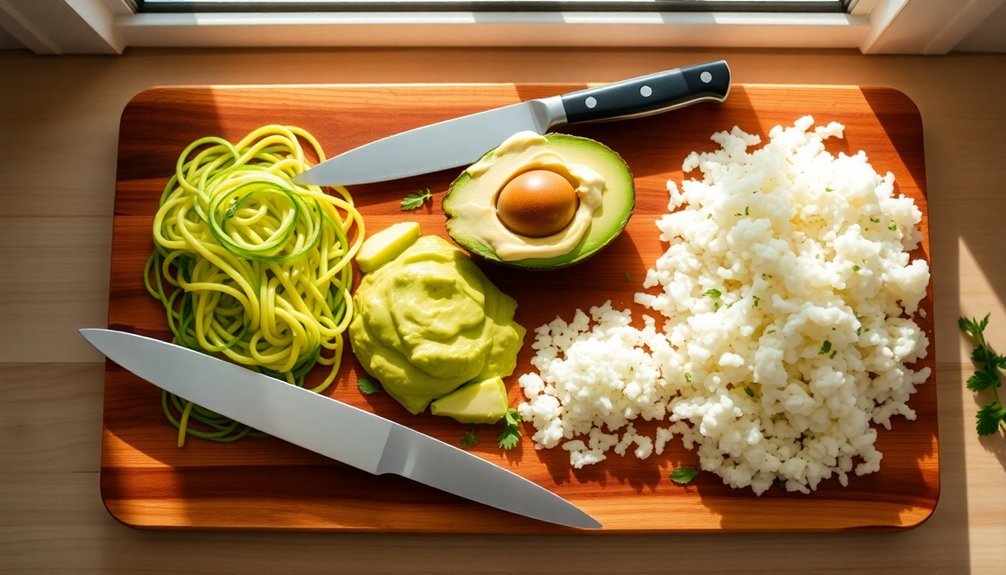



Leave a Reply